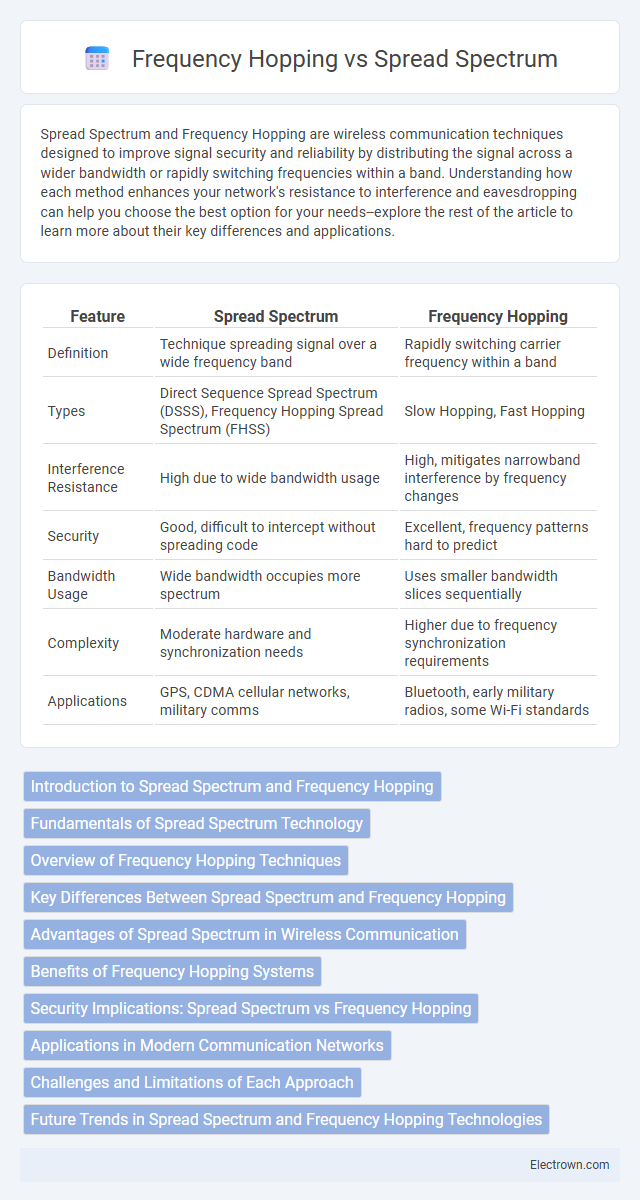Spread Spectrum and Frequency Hopping are wireless communication techniques designed to improve signal security and reliability by distributing the signal across a wider bandwidth or rapidly switching frequencies within a band. Understanding how each method enhances your network's resistance to interference and eavesdropping can help you choose the best option for your needs--explore the rest of the article to learn more about their key differences and applications.
Table of Comparison
| Feature | Spread Spectrum | Frequency Hopping |
|---|---|---|
| Definition | Technique spreading signal over a wide frequency band | Rapidly switching carrier frequency within a band |
| Types | Direct Sequence Spread Spectrum (DSSS), Frequency Hopping Spread Spectrum (FHSS) | Slow Hopping, Fast Hopping |
| Interference Resistance | High due to wide bandwidth usage | High, mitigates narrowband interference by frequency changes |
| Security | Good, difficult to intercept without spreading code | Excellent, frequency patterns hard to predict |
| Bandwidth Usage | Wide bandwidth occupies more spectrum | Uses smaller bandwidth slices sequentially |
| Complexity | Moderate hardware and synchronization needs | Higher due to frequency synchronization requirements |
| Applications | GPS, CDMA cellular networks, military comms | Bluetooth, early military radios, some Wi-Fi standards |
Introduction to Spread Spectrum and Frequency Hopping
Spread Spectrum technology transmits signals over a wide frequency band to enhance security and reduce interference, while Frequency Hopping rapidly switches carrier frequencies within a specified range to avoid eavesdropping and jamming. Both methods improve wireless communication reliability and privacy, but Frequency Hopping specifically divides data into short bursts sent over multiple frequencies in a pseudo-random pattern. Your wireless system's resistance to interference and interception can be significantly bolstered by selecting the appropriate spread spectrum technique.
Fundamentals of Spread Spectrum Technology
Spread Spectrum technology transmits signals over a wide frequency band to reduce interference and enhance security, while Frequency Hopping specifically changes carrier frequencies rapidly within a predefined sequence. Both techniques improve communication reliability by minimizing the impact of narrowband noise and jamming through signal spreading. Fundamentals include direct sequence spreading using pseudo-random codes and frequency hopping patterns that synchronize transmitter and receiver for robust wireless communication.
Overview of Frequency Hopping Techniques
Frequency hopping techniques rapidly switch the carrier frequency over a predetermined sequence of frequencies, enhancing communication security and resistance to interference. These methods include slow frequency hopping, where multiple symbols are transmitted per hop, and fast frequency hopping, where the carrier frequency changes with every symbol, improving resistance against narrowband jamming. Your wireless system benefits from increased robustness and reduced signal interception risk through the effective implementation of frequency hopping spread spectrum (FHSS) technology.
Key Differences Between Spread Spectrum and Frequency Hopping
Spread Spectrum transmits signals across a wide frequency band to enhance resistance to interference and eavesdropping, while Frequency Hopping rapidly switches the carrier among various frequency channels within that band. Spread Spectrum techniques include Direct Sequence Spread Spectrum (DSSS) and Frequency Hopping Spread Spectrum (FHSS), with FHSS specifically emphasizing rapid changes to the carrier frequency. Key differences lie in their implementation: Spread Spectrum provides continuous wideband transmission for robustness, whereas Frequency Hopping offers discrete, time-synchronized frequency changes for enhanced security and reduced interference.
Advantages of Spread Spectrum in Wireless Communication
Spread Spectrum offers enhanced resistance to interference and eavesdropping by distributing the signal over a wide frequency range, improving wireless communication reliability and security. It minimizes multipath fading and signal degradation, ensuring consistent data transmission in crowded and noisy environments. This technique also allows multiple users to share the same frequency band with reduced risk of cross-channel interference, optimizing spectrum efficiency.
Benefits of Frequency Hopping Systems
Frequency hopping systems provide robust interference resistance by rapidly switching carrier frequencies within a wide band, minimizing the impact of narrowband jamming. They enhance security through unpredictable frequency changes, making eavesdropping and unauthorized access more difficult. Additionally, frequency hopping improves spectrum efficiency in crowded environments by allowing multiple users to share the same frequency band with reduced mutual interference.
Security Implications: Spread Spectrum vs Frequency Hopping
Spread Spectrum and Frequency Hopping techniques both enhance wireless communication security by minimizing interference and eavesdropping risks through signal dispersion. Spread Spectrum provides continuous frequency variation across a wide band, making interception difficult due to its low signal power density, while Frequency Hopping rapidly changes the carrier frequency within a predefined sequence, offering resilience to jamming and interception by limiting the time spent on each frequency. Your choice between these methods impacts the robustness of secure transmissions, with Frequency Hopping offering a more dynamic defense against targeted attacks.
Applications in Modern Communication Networks
Spread Spectrum and Frequency Hopping techniques are widely used in modern communication networks to enhance security, reduce interference, and improve signal reliability. Frequency Hopping is particularly favored in military communications and Bluetooth technology for its ability to rapidly switch frequencies, minimizing the risk of eavesdropping and jamming. Spread Spectrum finds extensive application in Wi-Fi and cellular networks, providing robust performance in congested environments and ensuring your data remains securely transmitted over shared frequencies.
Challenges and Limitations of Each Approach
Spread spectrum techniques face challenges such as increased bandwidth requirements and potential interference with adjacent channels, limiting their efficiency in congested frequency environments. Frequency hopping systems encounter limitations including synchronization complexity and vulnerability to jamming if hop patterns are predictable. Understanding these challenges can help you select the best method for secure and reliable wireless communication.
Future Trends in Spread Spectrum and Frequency Hopping Technologies
Future trends in Spread Spectrum and Frequency Hopping technologies emphasize enhanced security and increased resistance to interference in wireless communication networks. Advances in machine learning algorithms optimize frequency allocation dynamically, improving spectrum efficiency and reducing latency in IoT and 5G applications. You can expect these innovations to drive more adaptive, robust, and energy-efficient communication protocols for next-generation connectivity.
Spread Spectrum vs Frequency Hopping Infographic

 electrown.com
electrown.com